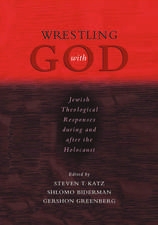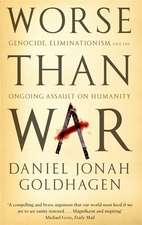After the Killing Fields: Lessons from the Cambodian Genocide
Autor Craig Carlyle Etchesonen Limba Engleză Hardback – 29 mar 2005 – vârsta până la 17 ani
Preț: 322.67 lei
Preț vechi: 392.62 lei
-18% Nou
Puncte Express: 484
Preț estimativ în valută:
61.74€ • 67.28$ • 52.03£
61.74€ • 67.28$ • 52.03£
Carte tipărită la comandă
Livrare economică 23 aprilie-07 mai
Preluare comenzi: 021 569.72.76
Specificații
ISBN-13: 9780275985134
ISBN-10: 027598513X
Pagini: 272
Dimensiuni: 156 x 235 x 24 mm
Greutate: 0.55 kg
Ediția:New.
Editura: Bloomsbury Publishing
Colecția Praeger
Locul publicării:New York, United States
ISBN-10: 027598513X
Pagini: 272
Dimensiuni: 156 x 235 x 24 mm
Greutate: 0.55 kg
Ediția:New.
Editura: Bloomsbury Publishing
Colecția Praeger
Locul publicării:New York, United States
Notă biografică
Craig Etcheson is a principal founder of the Documentation Center of Cambodia. He works with governments, international organizations, and NGOs in the search for ways to help heal nations that are recovering from genocide and other extreme violence. He has been a faculty member at the Johns Hopkins University, Yale University, and the University of Southern California. He is the author of several book-length treatises on extreme conflict, including The Rise and Demise of Democratic Kampuchea (1984).
Cuprins
List of IllustrationsPrefaceThe Thirty Years WarA Desperate TimeAfter the PeaceDocumenting Mass MurderCentralized TerrorTerror in the EastDigging in the Killing FieldsThe Persistence of ImpunityThe Politics of Genocide JusticeChallenging the Culture of ImpunityNotesBibliographyIndex
Recenzii
More than 25 years after the fall of the Khmer Rouge regime, those responsible for genocide and human rights violations in Cambodia have yet to answer for their crimes. Why has justice for the Cambodian people been so elusive? Etcheson argues that a culture of impunity persists in Cambodia, and that national reconciliation and healing will require a properly conducted war crimes tribunal, perhaps overseen by the UN. The author describes the efforts of the Documentation Center of Cambodia in amassing proof that the leaders of the Khmer Rouge ordered mass executions throughout Cambodia during the 1975-79 regime. But the abuses began earlier and continue to the present. Moreover, no one in Cambodia's political elite is completely untainted. Etcheson's historical and legal concerns are intertwined, since the evidence from documents, interviews, and eyewitness accounts, backed up by physical evidence from mass graves, is meant to combat the denial syndrome that is part of Cambodia's tragic and apparently intractable situation. These essays will appeal mainly to specialists in Cambodian political history and international politics, as well as to other readers interested in legal remedies for political violence and genocide. Summing Up: Recommended. Graduate students/faculty.
^IAfter the Killing Fields: Lessons from the Cambodian Genocide^R is a thorough insider's description of the Documentation Center of Cambodia's valuable work. More importantly, the book probes the culture of impunity and enhances our understanding of this extraordinarily complex issue. It is a major contribution to genocide studies, as well as an eloquent tribute to the Cambodians who suffered under the Khmer Rouge.
[E]tcheson's great contribution is his orderly, detailed relating of DC-Cam's postwar research into the organization and location of mass murder as well as international legal efforts to bring surviving perpetrators to account.
After the Killing Fields is a thorough description of the step-by-step accumulation of evidence of Khmer Rouge crimes.
^IAfter the Killing Fields: Lessons from the Cambodian Genocide^R is a thorough insider's description of the Documentation Center of Cambodia's valuable work. More importantly, the book probes the culture of impunity and enhances our understanding of this extraordinarily complex issue. It is a major contribution to genocide studies, as well as an eloquent tribute to the Cambodians who suffered under the Khmer Rouge.
[E]tcheson's great contribution is his orderly, detailed relating of DC-Cam's postwar research into the organization and location of mass murder as well as international legal efforts to bring surviving perpetrators to account.
After the Killing Fields is a thorough description of the step-by-step accumulation of evidence of Khmer Rouge crimes.
















